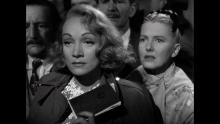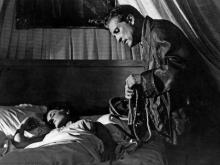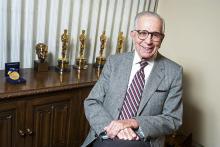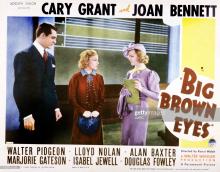These notes on Avanti! were written by John Bennett, PhD candidate in UW Madison’s Department of Communication Arts, the Cinematheque’s Project Assistant, and a Programmer for the Cinematheque and Wisconsin Film Festival. A 35mm print of Avanti! will screen on Saturday, April 29, at 7 p.m., in the Cinematheque's regular venue, 4070 Vilas Hall, 821 University Ave. Admission is free!
By John Bennett
In conceiving of the totality of Billy Wilder’s directing career, we can roughly segment it into four phases. In the first, he was a successful young hotshot at Paramount, experimenting in genres and narrative techniques. This period begins with The Major and the Minor (1942), culminates with Sunset Boulevard (1950) and collapses with the commercial failure of Ace in the Hole (1951). The second period covers much of the 1950s, during which Wilder somewhat conservatively stuck to adapting successful stage plays (Stalag 17 (1953), Sabrina (1954), The Seven Year Itch (1955)). The third phase came about with his initial collaborations with screenwriter I.A.L. Diamond; following the smash back-to-back successes of Some Like It Hot (1959) and The Apartment (1960), the two made a string of thinking-man’s sex comedies dripping (in varying degrees) with the director’s trademark cynicism (One, Two, Three (1961), Kiss Me, Stupid (1964), The Fortune Cookie (1966)). The films of the fourth and final phase (beginning with 1970’s The Private Life of Sherlock Holmes) are a bit more reflexive and elegiac. The Front Page (1974) saw Walter Matthau and Jack Lemmon revive the classic Hecht-MacArthur play from 1928 and Fedora (1978) is an operatic funhouse-mirror distortion of Sunset Boulevard. But the gem of this final period is no doubt Avanti!, perhaps the most sweet-tempered, life-affirming work of the director’s career.
Avanti! opens with businessman Wendell Armbruster, Jr. (Jack Lemmon) huffily making his way through an airport in Baltimore to catch the plane that will whisk him to the Italian island of Ischia. Though Ischia is known for its rejuvenating spas, its continental luxury hotels, and its sun-dappled scenery, Armbruster finds himself at the island’s Hotel Excelsior under sad and stressful circumstances. His father, the CEO of a powerful manufacturing company, has perished in a car accident on the picturesque island, and Armbruster is obliged to hack through a jungle of international red tape to ship the body back to Baltimore in time for a high-profile funeral (to be attended by Henry Kissinger and leaders of the AFL-CIO alike). The bureaucracy is enough of a headache for this impatient industrial heir apparent, but he soon finds he also must beat back a scandal—his father was not alone when his car careened off a cliff into a local vineyard, but rather in the company of a woman with whom he had been carrying on a secret affair for ten years. The woman’s daughter, Pamela Piggott (Juliet Mills), has also made her way to sunny Ischia from cloudy London to grieve a parent. Armbruster, burdened by bureaucracy and scandalized by the secret life of his deceased father, initially meets Pamela’s eccentricities with irritation. Yet as Avanti! unfolds, Armbruster and Pamela dance a charming pas de deux of incipient romance of their own as they reckon with the idyllic extramarital contentment experienced by their deceased parents amid easy rhythms of the Ischian dolce vita.
Avanti! was not particularly successful at the box office, losing about $700,000 according to biographer Ed Sikov. By 1972, Wilder was working in a profoundly transformed film industry. The 1960s had been relatively kind to Wilder: The Apartment won Oscars for best screenplay, direction, and picture for 1960, and 1963’s Irma la Douce was one of the director’s biggest box-office successes. But if the decade opened with celebrations of films like The Apartment, it closed with an embrace of radically modern films like Midnight Cowboy, which won the best picture Oscar for 1969. Indeed, the gentleness of Avanti! ran counter not only to the cynical bite of many of Wilder’s films, but also to the youthful sexual frankness being explored by filmmakers like John Schlesinger, Ken Russell, Mike Nichols or Dennis Hopper. The film also has a certain quaintness compared to the deluge of foreign films flooding American screens at the time. Wilder himself was acutely aware of this after the film disappointed at the box office. “Audiences nowadays want something juicier. Today, when there are movies like Brando’s Last Tango in Paris, it’s obviously not perverted enough,” he lamented to an interviewer.
Yet though the liberalizing of sexual mores in global cinema produced many vital explorations of eroticism, too much perversion would have curdled Avanti!’s refreshingly life-affirming breeziness. Several aspects of the film contribute to this anomalous tone. First, Avanti! is one of the director’s longer films. At two hours and twenty-seven minutes, Avanti! is surpassed in runtime only by Irma la Douce, which is three minutes longer. But where Irma la Douce becomes somewhat bogged down by its various running gags and subplots, Avanti! uses its longer running time to open up and decant like a fine wine that might be served by the Hotel Excelsior. Slowing down to savor life is one of the film’s major thematic preoccupations, and the longer running time endows the film with an unhurried pace, conveying a sense of leisure so championed by Pamela Piggott. With Pamela Piggott, Wilder allows a sincere tenderness (so strongly suggested by previous characters of his like Phoebe Frost in A Foreign Affair or Sugar Kowalczyk in Some Like It Hot) to burst forth. Her joie-de-vivre, so sweetly brought to life by the wide-eyed candor of Juliet Mills’ performance, serves as the moral compass of the film (even if the prominent storyline of her “weight problem” seems slightly ridiculous fifty years later). Also adding to the warmth of the film is Luigi Kuveiller’s gleaming cinematography. Wilder occasionally used color photography in his films, but he clung to black-and-white images as late as 1966 with The Fortune Cookie—years after the Hawkses and the Hitchcocks of the studio era permanently switched to color. Despite Wilder’s general predilection for the monochrome, Avanti! is drenched in hot sunlight that glimmers on the waters of the Mediterranean just as it floods Armbruster’s spacious hotel suite; the film’s images are as warm as its sentiments. Actor Clive Revill contributes to this tone in his amiable supporting turn as Carlo Carlucci, the industrious and discreet manager of the Hotel Excelsior. Ultimately, though, the hominess of Avanti! may be a result of the fact that Wilder was quite at home with two of his most trusty collaborators. The film marked the director’s fifth collaboration (out of seven) with Jack Lemmon. The two were quite close: they were friends and neighbors in Los Angeles, and Lemmon could strike a balance between neuroticism and heart that meshed well with Wilder’s romantic farces. Wilder was also quite at home with his co-screenwriter, I.A.L. Diamond. The two first joined forces on the screenplay for Wilder’s Love in the Afternoon in 1957 and worked together on every one of Wilder’s films after Some Like It Hot. With its relaxed pacing, its affable performances, its comfortable collaborations, and its general celebration of life, Avanti! feels like a refreshing breath of warm Mediterranean sea air.










